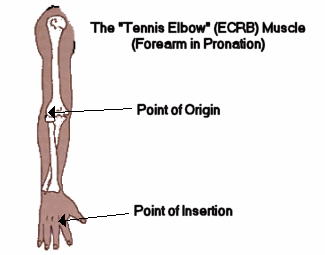|
"OBP Cures Tennis Elbow!" - A new approach to the problem of tennis elbow cures!
|
Upon reading this article, the reader will be able to:-
- Give a simplified description of the damaged part and the causes of
that damage.
- Perform some "Get to know your wrist and forearm" exercises.
- Be able to put together a tennis elbow tendonitits treatment and management plan that will
supplement and enhance the therapy provided by their chiropracter or physiotherapist.
(Note: A full examination for other causes of elbow and forearm pain such
as spinal nerve impingements, arm nerve impingements etc. is always
strongly advised, and your chiropractor, doctor or physiotherapist has the
clinical training and experience to provide this).

Tennis Elbow, Background Information:
Tennis elbow, or lateral epicondylitis is a very common condition in
the over 35 year old. It represents approximately 70% of all sporting
injuries in persons over 40 to 50 years of age (1).
Most patients presenting with tennis elbow are in fact 35 years of
age or older, and the development of tennis elbow may be due to
age-related tissue changes (2). Confusion about the pathology and
treatment of tennis elbow has plagued the medical community since
the 19th century (2).
The names themselves are misleading. Tennis elbow can be suffered
by tennis players, but any repeated loading of the specific
musculo-tendinous unit will bring about the condition. The damage
is especially likely if there is a jarring component in the activity
(e.g. pole planting while skiing, hammering or chopping wood) , or the
body parts closely associated with the musculo-tendinous unit
are working outside of their optimal range of movement (e.g. wielding
a screw driver, which demands the full range of forearm rotation,
or wrist flexion/extension exercises at the gym, which unless
properly supervised will often call upon the person to work the
wrist and forearm outside of their optimal ranges of movement).
Likewise, lateral epicondylitis does not describe the actually
disease process. The bony outside prominence of the elbow (or
lateral humeral epicondyle) is indeed distressingly painful,
but the actual disease process is a tearing and pulling apart
of the tendon inserting on that bony point, often with a limited
inflammatory response, and with very poor healing.
Medical Texts not able to provide a unified theory...
Medical text book descriptions of the precise mechanism of injury,
while accurate, do not provide a unified theory from which to teach the
patient a therapeutic plan...
Take for example these discussions of cause:
- "Certain movements... involving wrist extension or gripping, will
aggravate mechanical pain." (Ref 3, page 275)
- "Referred pain is affected by prolonged posture, such as lengthy
periods seated at a desk or in a car..." (3 page 275)
- ...phase of recovery in which pain induced splinting occurs
(Ref 2, page 10)
- "A degenerative disorder... The inflammatory response that characterizes
the disorder is an attempt to speed the rate of tissue production to
compensate for an increased rate of tissue microdamage (e.g. collagen
fibre fracturing)... this [increase in rate of damage] might occur
from some increase in use of the tendon- for example, with carpentry,
pruning shrubs, or playing tennis. It may also occur with normal
activity levels if the tendonís capacity to attenuate tensile load
is reduced. This typically occurs with aging, in which a loss of
the mucopolysaccharide chondroitin sulphate make the tendon less
extensible; more of the energy of tensile loading must be absorbed
as internal strain to collagen fibres rather that by deformation of
the tissue." (Ref 2, page 229)
All the above quotes give small insights, but the "big picture" is yet to be
painted. I hope to remedy that situation with this article!

Simplified Description of Tennis Elbow
|
In Tennis Elbow, the key injury is small tears of the tendon at the upper
end of the extensor carpi radialis brevis muscle (ECRB for short).
The tears result in an aching pain on the outside of the elbow, which
often radiates down the forearm. Over time, and in severe cases, the
whole tendon turns to jelly, and separates from the bone.
Unfortunately, the jelly like area is full of pain sensors.
Surgery to remove the jelly and suture the tendon back on its moorings
works surprisingly well: pain and muscle spasm abates immediately, and
will not recur provided the patient learns improved and gentler patterns
of use. (One exception to this seems to be that of the wheel chair
paraplegic: this category of patient often requires repeat surgery).
In most cases, and with the "back to basics" approach you will get from
this article, you will not have to resort to surgery!
|

|
|
OBP Cures Tennis Elbow! - A new approach to a difficult problem!
|

Return to Top |
Proceed to page 2 of "Tennis Elbow Cures"...
© Bruce Thomson, EasyVigour Project

|
|
|